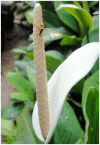Methyl eugenol: its occurrence, distribution, and role in nature, especially in relation to insect behavior and pollination
- PMID: 22963669
- PMCID: PMC3500151
- DOI: 10.1673/031.012.5601
Methyl eugenol: its occurrence, distribution, and role in nature, especially in relation to insect behavior and pollination
Abstract
This review discusses the occurrence and distribution (within a plant) of methyl eugenol in different plant species (> 450) from 80 families spanning many plant orders, as well as various roles this chemical plays in nature, especially in the interactions between tephritid fruit flies and plants.
Figures









Similar articles
-
Mating activity of Bactrocera cacuminata (Hering) (Diptera: Tephritidae) on its larval host plant Solanum mauritianum Scopoli in southeast Queensland.Bull Entomol Res. 2008 Feb;98(1):77-81. doi: 10.1017/S0007485307005408. Epub 2007 Dec 13. Bull Entomol Res. 2008. PMID: 18076777
-
The ecological consequences of herbivore-induced plant responses on plant-pollinator interactions.Emerg Top Life Sci. 2020 Jul 2;4(1):33-43. doi: 10.1042/ETLS20190121. Emerg Top Life Sci. 2020. PMID: 32537636 Review.
-
Pre-release consumption of methyl eugenol increases the mating competitiveness of sterile males of the oriental fruit fly, Bactrocera dorsalis, in large field enclosures.J Insect Sci. 2010;10:8. doi: 10.1673/031.010.0801. J Insect Sci. 2010. PMID: 20569140 Free PMC article.
-
Different methods of methyl eugenol application enhance the mating success of male Oriental fruit fly (Dipera: Tephritidae).Sci Rep. 2018 Apr 16;8(1):6033. doi: 10.1038/s41598-018-24518-5. Sci Rep. 2018. PMID: 29662085 Free PMC article.
-
Integrating Studies on Plant-Pollinator and Plant-Herbivore Interactions.Trends Plant Sci. 2016 Feb;21(2):125-133. doi: 10.1016/j.tplants.2015.10.013. Epub 2015 Nov 17. Trends Plant Sci. 2016. PMID: 26598297 Review.
Cited by
-
Unraveling the Potential of Organic Oregano and Tarragon Essential Oils: Profiling Composition, FT-IR and Bioactivities.Plants (Basel). 2023 Nov 29;12(23):4017. doi: 10.3390/plants12234017. Plants (Basel). 2023. PMID: 38068651 Free PMC article.
-
Effects of Harvest Timing on Phytochemical Composition in Lamiaceae Plants under an Environment-Controlled System.Antioxidants (Basel). 2023 Oct 25;12(11):1909. doi: 10.3390/antiox12111909. Antioxidants (Basel). 2023. PMID: 38001762 Free PMC article.
-
Characterization of Cultivar Differences of Blueberry Wines Using GC-QTOF-MS and Metabolic Profiling Methods.Molecules. 2018 Sep 17;23(9):2376. doi: 10.3390/molecules23092376. Molecules. 2018. PMID: 30227669 Free PMC article.
-
Effects of the floral phytochemical eugenol on parasite evolution and bumble bee infection and preference.Sci Rep. 2018 Feb 1;8(1):2074. doi: 10.1038/s41598-018-20369-2. Sci Rep. 2018. PMID: 29391545 Free PMC article.
-
Toxicity of Plant Secondary Metabolites Modulating Detoxification Genes Expression for Natural Red Palm Weevil Pesticide Development.Molecules. 2017 Jan 20;22(1):169. doi: 10.3390/molecules22010169. Molecules. 2017. PMID: 28117698 Free PMC article.
References
-
- Abdon APV, Leal-Cardoso JH, Coelho-de-Souza AN, Morais SM, Santos CF. Antinociceptive effects of the essential oil of Croton nepetaefolius on mice. Brazilian Journal Medical and Biological Research. 2002;35:1215–1219. - PubMed
-
- Abduelrahman AHN, Elhussein SA, Osman NA, Nour AH. Morphological variability and chemical composition of essential oils from nineteen varieties of Basil (Ocimum basilicum L.) growing in Sudan. International journal of Chemical Technology. 2009;1:1–10.
-
- Aboutabl EA, Tohamy SFE, De Pooter HL, De Buyck LF. A comparative study of the essential oils from three Melaleuca species growing in Egypt. Flavour and Fragrance Journal . 1991;6:139–141.
-
- Acharya RN, Chaubal MG. Essential oil of Anemopsis californica. Journal of Pharmaceutical Sciences. 1968;57:1020–1022. - PubMed
-
- Adams R.P. The leaf oil of Juniperus gracilior Pilger var. urbaniana (Pilger & Ekman) R.P. Adams: Comparison with other Caribbean Juniperus species. Journal of Essential Oil Research . 1997;9:641–647.
Publication types
MeSH terms
Substances
LinkOut - more resources
Full Text Sources

